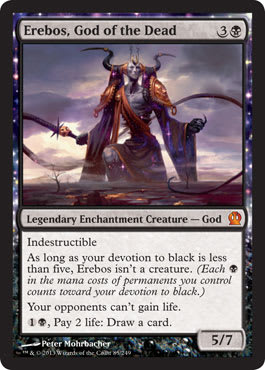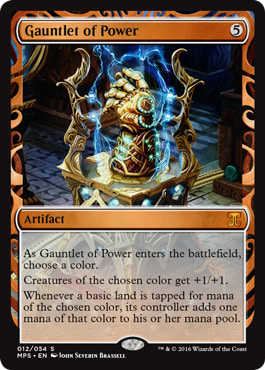As a recognizable member of the Magic community who travels a lot, I tend to meet a great deal of people at events. Some just want to let me know how they feel about my article series or the podcast, while others take this opportunity to pick my brain. I have been greatly humbled over the past few years to have gained the following I have, and to each of you who reads this, I want to thank you. I encourage anyone who sees me at an event to stop me for a chat; I will always find time and love to hear feedback. This, of course, is not the topic of this week’s article, but as the topic was somewhat user-submitted, I did want to take time to thank everyone—it is nice to know that my advice does not fall upon deaf ears.
This week, I want to talk about what is probably the most-asked question I receive and ties very much into the entire theme of this series: How do you sustain a collection long-term? This seems like such a simple question on the surface; yet, it has been talked about time and time again by some of the best minds in this game, both financial and otherwise. The truth is there is no one way to sustain your collection, no best method for allowing Magic to remain within your budget, and there is not some guide that will one-hundred-percent allow you to keep grinding while not decimating your wallet.
The entire subject requires what I believe to be months’ worth of articles, some of which I have already written. For this week, and those coming that do not already have a scheduled topic, I am going to talk about finding the best way for your collection to support your hobby while still understanding the different levels of commitment and what benefits each can have. No one method will work for everyone, and though there are certainly crossovers that can benefit everyone, your collection and way of managing it should very much reflect what you are looking to get out of Magic. This series is not for those people looking to grind value and make a living, such as I do, but it is instead aimed toward the guy who plays Commander once a week with his friends or the Friday Night Magic grinder who is still in high school and may not have much disposable income. Each week, I will talk about a different facet of player and how those players can take advantage of their current knowledge bases in order to create cheap and manageable ways to sustain.
This week, I am going to start with Commander players, as that seems to be the most common crowd I hear this question from. The convenient part about Commander is that it can be relatively cheap to get into the format. As you gain value or invest money, you can slowly grow both the power level of your decks as well as the value of your collection without much worry of the current metagame or what placed well last weekend. This means you can ignore the market at times when Magic is not your primary concern—and you can do so with relative ease that your cards will not suddenly tank in price. This has changed slightly with the reprints in Duel Decks and sets such as the preconstructed Commander decks, but the theory still remains relatively sound.
As a Commander player, the selection of cards you are seeking during spoiler season is probably very different than those looking at the more competitive formats. While your friend who attends Grands Prix or plays competitively is looking for his Thoughtseizes, you are seeking staples such as Thespian's Stage or Lightning Greaves. Unlike competitive cards, the causal market usually takes a relatively long time from the beginning of a spoiler season until those cards that you are seeking gain any value, thus giving you a strong window of opportunity to gather what you can, even if you are on a budget. An example of this is a card such as Parallel Lives, which appears to most people as bulk, yet it may fit into a token deck you are making just fine. The card was worth less than a dollar for the first half of its life in Standard, and it spiked as high as $4 during a point when it was potentially playable, but it is now back down to around $2, which seems more than fair for what the card does in popular strategies.
Learning how to maximize your understanding of a format can allow you to make some great long-term investments, and unlike competitive players, you don’t need to be on the ball for to make money. Rarely, barring a reprint, does a Commander card spike up in value to only then drop again in a short time. This means that even if you only trade casually for cards, you have a large window to pick them up while they are cheap, and at the same time, you can sell out at any point without too much worry of potential loss. Even the printing of functional reprints or cards with similar effects will not usually hurt a price for older cards, as the format is Highlander, and in turn, decks can be easily tuned without losing much of what you had before.
As a Highlander format, it is also convenient that you are only seeking single copies of cards, as this does not force you into looking for play sets of new hot cards that may be pricier. Trading for one Snapcaster Mage sounded a lot better during its heyday than trying to find a set, and in this regard, Commander is probably among the best options for players on a budget who still have some competitive spirit. Unlike with the competitive player, it is rare that an expensive card comes along that you must have to make the theme of your deck work—that means even if a card is out of range now, it will probably drop as the set is opened more—or else in a few years as it rotates. Patience is the key to sustaining a Commander collection, as most of the staples will only gain value, which means you should rarely be in a rush to move anything, and if you wait long enough, most cards will drop in value, making them more accessible and damaging your trade binder less.
As a guide for the format, I suggest looking at cards you notice have not seen a reprint in a while that have begun creeping up in popularity or price. From there, evaluate how easy these cards would be to reprint; for example, a card that is mechanic-specific, such as Huntmaster of the Fells, is less likely to be reprinted en masse while a card such as Gauntlet of Power could fit very easily into a core set. From there, set a few binders up, with each containing extra copies of cards you may no longer need or have replaced, and section them off based on how willing you are to move them. Have a primary binder that acts as your trade stock—this should be full of everything you feel may be reprinted or gain little value over time. Another binder should have your stock of cards that you may be more hesitant to trade but that can be broken into if you find something you are truly seeking and your trade partner cannot come to an agreement merely from the first binder. The third binder—or even a box—can be used to keep any cards you know you will use in the next year—or perhaps cards you are just looking to hold for long-term value. This box or binder does not need to leave your home unless you are using it to build a deck. If a card is not something you are looking to part with at the current market value, keep it from the public eye. The hardest time I have with Commander players in trade is that they are hesitant to move a lot of cards in their binder due to playability or value, and segregating these cards from those you are happy to part with will make each trade go much smoother.
There are countless other things you can do to sustain a Commander collection, some of which I will cover at a later date, but if this sounds like you, evaluate what you are doing now to gain cards, and see if anything I mentioned may allow you an easier time obtaining or getting rid of cards. To recap, the most important thing is to have patience and to not be afraid to trade for more than one copy of a card you believe will hold long-term value. If you see a card on a spoiler that appeals to you, it will probably appeal to others within Commander as well, and though it may take time, it will be worth picking up copies while they are cheap. Let the competitive players deal with the expensive end of Magic, and instead allow those cards to depreciate some before you rush into the fray.
Thank you again for the feedback I receive each and every week from you guys. If you feel you have any more tips or tricks to Commander trading, please feel free to leave them below or message me on Twitter.
Ryan Bushard




























